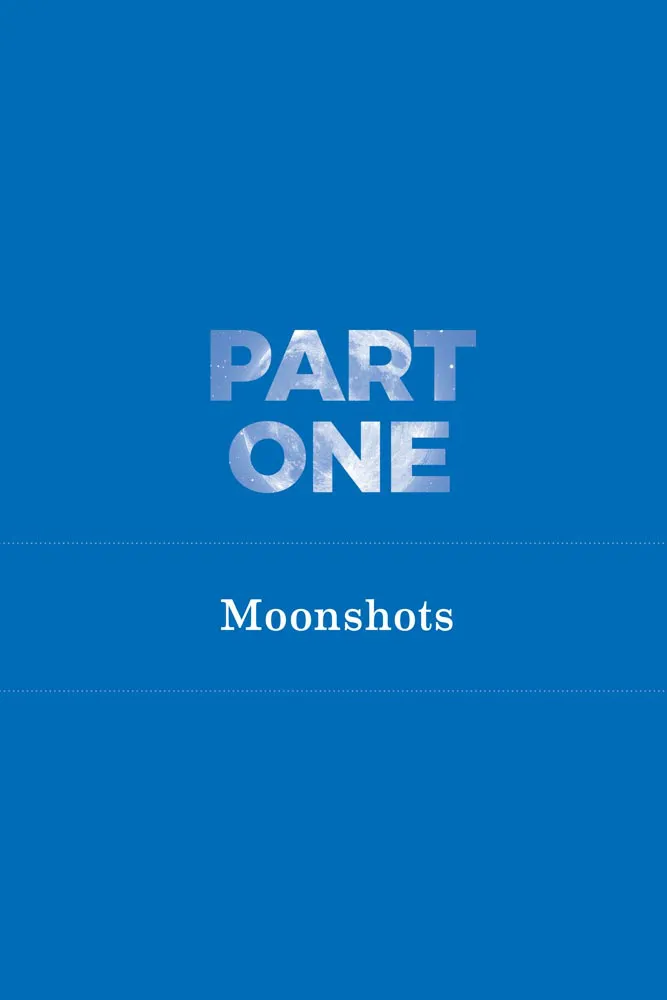![]()
Ready to undertake a moonshot? In the chapters that follow, we will deconstruct the Kennedy Moonshot to extract what we can replicate and apply to moonshots in business. We’ll use examples from the moonshots we have been involved with to demonstrate how they impact business, elevate leaders, and create high-performing people and teams.
You may identify and articulate your moonshot yourself, inspiring others around you to share your vision as President Kennedy did. Or your role may be to empower your team to generate ideas and find a compelling moonshot for your organization.
Whether you initiate the moonshot directly or provide support and urgency for others to set the course, the seven chapters in this section offer essential guidance. They are:
- FROM THE MOON TO EARTH: Applying the magic of the moon in business
- THE ESSENTIAL INGREDIENTS OF A MOONSHOT: How high the moon?
- CHOOSE YOUR MOON: Set the target for your moonshot
- LIFTOFF: Break free of business as usual
- EXPECT THE UNEXPECTED: The moonshot effect
- MOONSHOTS AND STARTUPS: Entrepreneurs who shoot for the moon
- THE LAUNCH PLAN: Seven steps to a moonshot
![]()
FROM THE MOON TO EARTH
The Magic of the Moon in Business
A moonshot taps into human aspirations to achieve something unexpected, difficult, and worthwhile.
There’s no better template to leadership and organizational impact of a moonshot than John F. Kennedy and the Apollo 11 mission. But the book you’re reading right now is about business, so we will also consider two well-known examples in industry: Alcoa in the 1980s and 1990s, under the leadership of CEO Paul O’Neill, and GE’s Ecomagination initiative, instigated by CEO Jeff Immelt. They share characteristics that differentiate them from ordinary, aggressive business goals and instead catapult them to the level of a moonshot.
In the chapters that follow, we will dig into these stories, the qualities that link them, and what we can learn from them.
TO THE MOON AND BACK IN THE DECADE
In May of 1961, in the opening months of his presidency, President John F. Kennedy stood before Congress and the American people. In a speech titled “Urgent National Needs,” he surprised Congress and the nation with his bold challenge to send a man to the moon and back before the end of the decade.
“ I believe that this nation should commit itself to achieving the goal, before this decade is out, of landing a man on the moon and returning him safely to Earth. „
JOHN F. KENNEDY,
speech to Congress, May 1961
As the original Moonshot that coined the term, you cannot get much bigger than this.
The objective surprised nearly everyone—especially those who understood what this challenge would truly entail. It was ambitious, unexpected, and galvanizing. The mission required the dedicated, coordinated efforts of hundreds of thousands of engineers and scientists and a budget more than $20 billion. Technologically, the experts were not certain the goal was possible, particularly within the constrained time frame.
As we will see in the chapters that follow, the Moonshot faced constant opposition and challenges. For the president, the stakes were high.
The speech took place one month after the Soviet Union sent the first man into space. America lagged its Cold War adversary in the space race, which was part of the escalating arms race between the countries. As mentioned earlier, Kennedy wanted to demonstrate America’s leadership on the international stage. Reaching the moon first would be a clear win. The objective was as much political and cultural as technological.
The Apollo 11 mission met Kennedy’s deadline by mere months. At the end of a tumultuous decade in the United States, the moon landing restored a collective national confidence. Although he did not live to see its fulfillment, Kennedy’s legacy and leadership will be forever intertwined with the moon.
The story of the Moonshot continues decades after the astronauts’ return to Earth. The effort instigated a series of scientific and engineering innovations, yet the greatest effect of the lunar mission may have been proving that when people work together in service of an aspirational and worthwhile objective, they rise to new levels of performance.
ALCOA SHOOTS FOR PERFECTION
Imagine for a moment that it is 1987, and you’re an investor in Alcoa, the aluminum-manufacturing giant. You sit in an investors meeting, waiting to hear the latest CEO’s plans for the company. Alcoa has faltered recently with failed product lines. You’re hoping that the new guy, Paul O’Neill, has a plan to increase revenues and improve profitability.
Instead, O’Neill talks about worker safety, saying, “Every year, numerous Alcoa workers are injured so badly that they miss a day of work. Our safety record is better than the general American workforce, especially considering that our employees work with metals that are 1500 degrees and machines that can rip a man’s arm off. But it’s not good enough. I intend to make Alcoa the safest company in America. I intend to go for zero injuries.”
Processing aluminum is hazardous; injuries were considered a regrettable but expected cost of doing business in the manufacturing industry. Alcoa at the time ranked in the top third of American companies for the fewest days lost to injury. Safety was an unlikely focus for the newly appointed CEO, given other issues facing the company, such as rising costs, labor unions, and market expansion.
But the enormous human toll of injuries became the focus for O’Neill’s moonshot. The company gave the initiative the label “Zero is Possible,” and it is still in place today. An example of the practices the company has installed to prevent life-threatening injury is their forklift safety policy. To avoid forklift-related injuries, employees must be in direct communications with the forklift operator before they are within three feet of their approach. Pedestrians in areas with high forklift traffic are required to wear safety vests.
Focusing intently and exclusively on worker safety turned out to be transformative. Alcoa’s safety record became the industry ideal. During O’Neill’s tenure at the company, injury rates at Alcoa dropped from 19 lost days per 1000 workers to less than two days—almost a tenfold decrease.
“Zero is Possible” was also good for business. In 2007, when O’Neill left to become U.S. Treasury Secretary, Alcoa’s annual net income had grown five fold and its market capitalization had increased by $27 billion.
Clearly, many factors contributed to the company’s financial performance during O’Neill’s tenure. The safety initiative unlocked communications and innovation in ways that benefitted performance. But the core objective was about people, not profits. No matter the cause, the focus on safety did not hurt business performance. O’Neill proved the naysayers wrong.
GENERAL ELECTRIC’S ECOMAGINATION
In 2005, General Electric CEO Jeff Immelt announced that he was shifting the company to producing energy-efficient, ecologically friendly products, starting with a major investment in a program called “Ecomagination.” At the time, GE was not a likely candidate to focus a program on developing environmentally efficient products. At the time, the company was widely believed to be one of the largest corporate polluters in the United States. Skeptical observers dismissed Immelt’s announcement as a PR ploy designed to greenwash the company’s poor environmental record. As with Paul O’Neill’s announcement about worker safety at Alcoa, the initial reaction was one of surprise and disbelief.
Ten years later, the initiative has turned out to be a remarkably successful reinvention of GE. The company expects corporate purchases of eco-friendly machinery to drive significant growth by 2020, with fuel cell installations growing by 400 percent. It anticipates a fourfold increase in sales of LED lighting. Immelt’s program has positioned the company with a significant business advantage.
A true commitment to the “Ecomagination” moonshot required GE to reengineer its entire product line for energy efficiency, including clothes dryers, lightbulbs, and jet engines. When Immelt called on Lorraine Bolsinger, Chief Marketing Officer for GE Aviation at the time, to run the program in 2005, products within the Ecosystems category accounted for $10 million in revenue. Bolsinger and Immelt established the following clear, urgent targets:
- Double GE’s $700 million research and development (R&D) investment in clean technology by 2010
- Turn a projected 40 percent increase in greenhouse gas emissions to a 1 percent reduction by 2012
- Cut its own use of water by 20 percent by 2012
“Ecomagination” proved successful...


